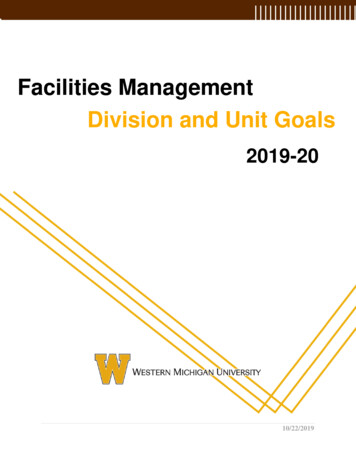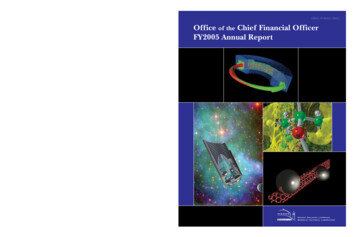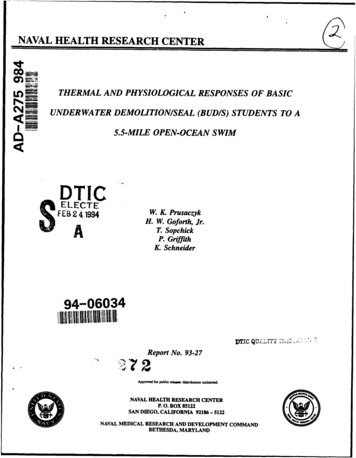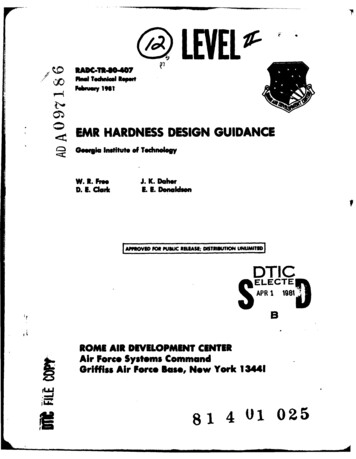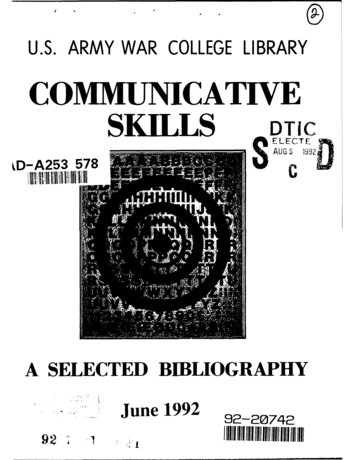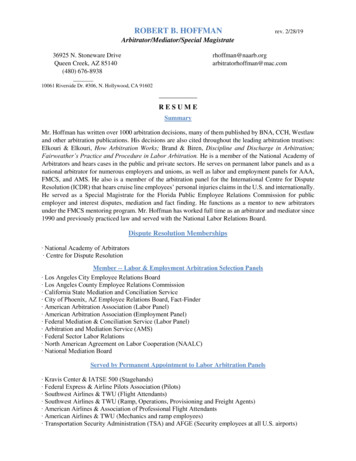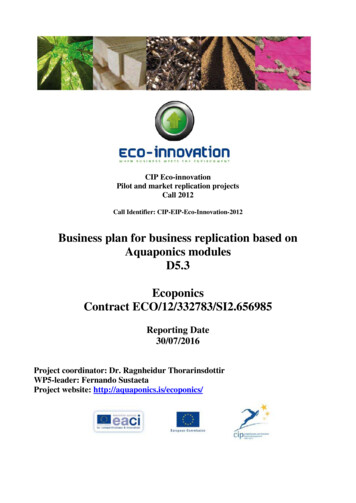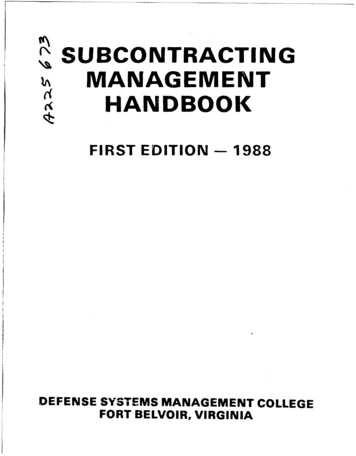
Transcription
SUBCONTRACTINGMANAGEMENTHANDBOOKFIRST EDITION-1988DEFENSE SYSTEMS MANAGEMENT COLLEGEFORT BELVOIR, VIRGINIA
PREFACEWith increasing weapon system complexitNand sophistacaton, prime contractors mustinvariably re1on more and moreszbcontractor support to provide theneeded skills, capabilities, or productwith which to produce such weaponsAnumber of stuJie; and .'eports, over thEpast years, ha'e indicated that the costand amount of the subcontracted portionof many weapon ssstem acquisitions havebecome equal to rr greater than that ofthepýrimecontractorsAs thesepercentages have continued to increase,prime contractors ha'e indicated that theNare also experiencing significat t cost andsched-ile d-fficulties that are attribut3bleto ot are the .esult of subcont:actors"probemsIn discussing subcontractor control, asrelated to the abo'.e acquisition en'ironinent, DoD) Manual 4245 7-M 1statesthat more emocasrs Qn effecti'e mar-agemcntofsubcQntraztorsisCleariNsition to production To epsure the timelyacquisition and deployment of highlNrehable and effective weapon systems,however, one must address subcontractingissuei throughout the acquisition andeeployientphases.This canbeac3omnflishedbytheGovernmeItprzimoting andfacilitatingsuccessfulprime contractor interac:ions with subcontractors withoui impinging on theprivity of the contracts between the prrmeand the subcontractors.Unhke theconcept of subcontract management that isprimarilyconcernedwithcontractorprocurement systems, this concept ofintensifiedGovernmentact.vsItisreferred to as subcontra:ting managementand encompasses the fanctions If planningand managementotkey aspents ofsubcntvcted effT.rts, t;hrough enhancedGovernment coordination and intera:tionwith prartcontractorsRE ENCEneeded within indlustr\ernMient'sSitfand in thc 0,.ma.aagement ofth.!re is to be a smooth tran-1.I"DoDManual4245 7-M,DNveoprmnt to Produci.on."-'TransatmoAe6efslon ForrTISTrGA&veDTV1 TA; ''jutDintfromSeptember 1981,. p 5 1iIf ent !'n.Spacial
:TABLE OF CONTENTS1.0INTCTION1-1LI. Purpose1.2 Discussion-I1.3 Handbook Orlr ,aizLation .1.4 Terms Usage .1.O Refe.-'ence Citation12.01-2.1-31-3SU1CONwTRACT!NG MANAGEMENTr PERSPECTIVEwgkrordThe Proew and Its Complexities.Legistation and RegulationRisk Management and Good BusinessCAS Components Descriptions andDifferences2.6 Interorganizational Transfers 2-82.7 Subcontracting Management vs. SystemLife Cycle2.8 Subcontracting Management ING MANAGEMENT CONCEPT,ENVIRONMENT AND TECHNIQUES3.1 Need for Subcoatracting Management3.2 Regulatory Balis3.3 Environment and ACQUISITION MANAGEMENT4.1 Weapon System Acquisition Life CyclePhases4.2 Subcontracting Management Functions byPhases4-1ACQUISITION STRATEGY5.1 Acquisition Strategy and Planning5.2 Acquisition Plan5.3 Non-Development Items (NDIs)5-I5-I5-iCOMPETITION6.1 Competition Planning and Requirementsfor Selecting Prime Contractors6.2 Sub-Tier Competitin6.3 Subcontracting Source SelectionCAPITAL INVESTMENT7.1 Discussion.7.2 Manufacturing Technology (MANTECIH)ii4-14-3546-16-16-36-37-I7-I. 7-1
TABLE OF CONTENTSPAGE- NO7.3 Industrial Modernization Incenti 'esProgram (IMIP)8.07-2PNIO AND CAS TEAM APPROACH8-18 1 Program Support9-18.2 MOAs and Delegation Letters8.3 Defensc Priorities and Allocations8-28-5S stem (DPAS)'%4 Problem Identification. Resolution,and Status Reporting8.5 Cost and Price Review of Subcontractor8-698-7Propoals3 6 Technicit Revie% of SubcontractorPr ,rosals 8-89.0CRITICAL SUBCONTRACTING ASPECTS9 I Source Selection9 2 Flowdown of Specifications, StandardsTerms and Conditions9 3 Make-or-Buy Program9 4 Interorganizational Transfers9 5 Subcontract Competition9 6 Rights in Technical Data and ComputerSoftware9.7 Patent Rights9 8 Subcontract Management Plan9 9 Subcontrcting Plan (Small Businessand Small Disadvantaged Busmess).Q 10 Labor Surplus Subcontracting Program9 11 Equal Employment Opportunity (EEO)Clearance9 12 Subcontract Kicktacks9 13 Progress Payments9.14 Termination Settlements9.15 Subcontractor Program Status Report10.010.110.210.310.410 510.6CRITICAL ACQUISITION ASPECTSSurveillanceQuality AssuranceVendor Quality SurveysComponent BreakoutLeadtime Analysissource and Receiving Inspection andTestIll9- 110-110-210-310-410-510-6
TABLE OF II 211.311 411 511 611 711 8PAGE NO.Vendor Change ControlDesign Engineering ManagementVendor Performance Rating SystemSoftware Management SurveillanceGovernment PropertyIntegrated Logistic Support (ILS)CRITICAL TESTS & REVIEWSConsent Reviews of SubcontractingContractor Purchasing SystemReviewsCost/Schedule Control System Criteria(C/SCSC).Cost Monitoring Reviews (CMRs) 1-3Vendor Functional and PhysicalConfiguration AuditsVendor Preliminary and Critical DesignRe, iewsManufacturing Management and ProductionCapabiht, ReviesSubcontractor Manufacturing Rev ie's andAssessmentsAPPENDIX A. ACRONYMS AND TERMSAPPENDIX B. MEMORANDUM OF AGREEMENT (MOA)GENERIC EXAMPLE -iAPPENDIX C. SUBCONTRACT FLOWk DOWN CLAUSESeVEDERAL ACQUISITION REGULALiON (FAR)APPENDIX D. MASrER BIBLiOGRAPHYLIST OF FIGURESE(R--10-710-810-910-1010-1010-!I1il-.1 -111-111-211-311-411-511-5A-1C-ID-IPAGE NP.,1-1Subcontract Commitments2-1Typ.ca! Defense Contract AlministrationServices Management Area (DCASMA)Organization2-5Typical Defense Contract AdministrationSer,,ices Plant Representative Office.DCASPRO)"-52-2-2iv
TABLE OF CONTENTSLIST OF FIGURESFIGURE2-3PAGE NO.Air Force Plant Representative Office(AFPRO)2-62-4Army Plant Representative Office (ARPRO)2-62-5Naval Plan: Representative Office (NAVPRO)2-73-iGovernment and DoD Functional GuidanceRelated to Subcontracting Management.3-33-2Air Force Functional Gu dance Relatedto Subcontracting Management3-33-4Armx [unctional Guidance Related toto Subcontracting Management3-43-5NavN Functional Guidance ReI'vted toSubcontracting Management4-1.3-6Acc-uisition Program Review Milestonesfor )AB Prograrms 4-24-2Subcontractor Inolvement by AcquisitionPhase4-45-1Example of Varying Degrees of NDIs5-57-1IMIP and Program Baseline Adjustments 7-38-ISample Letter of Delegation8-4'I
CHAPTER 1.0INTRODUCTION1.1PURPOSEManagers with a ready reference document on relevant subjects pe:.ai-ing tothe acquisition of major and non-majorweapon systems. This handbook suppiements the information in the DSMCProgram Manager's Notebook by discussing the concept of subcontractingmanagement as it relates to the weaponsystem acquisition process. Further, thishandbook emphasizes the need for the PMand the PM Office (PMOj staff to beaware of all critical aspects of theirprogram's acquisition process with increased attention to the efforts of subcontractors.The purpose of this handbook is to provide a ready reference on subcontractingmanagement, for use by Department ofDefense (DoD) joint and single serviceacquisiticn Program Management Offices'(PMOs) staffs, Contract AdministrationOffices' (CAOs) personnel, and DefenseSystems Management College (DSMC)students and faculty.The handbookdiscusses relevant policies, procedures,responsibilities, as well as recommendedappro .-hes to subcontracting management,based on an evaluation of guidanceprovided by the Services.Fact Sheet 6.2.8 (July 1985) of the DSMCProgram Manager's Notebook cites thesignificant growth of subcontracted effortfrom twenty (20) to sixty (60) percent ofthe prime contract value during thetwenty (20) year period from 1965 to1985. Similarly, DoD Manual 4245.7-Mgnoted that: "the percentage of major weaponIt is assumed that personnel utilizing thishandbock have a basic understanding ofDoD's and the applicable Service acquisition processes and procedures.,1.2DISCUSSIONDoD Directive 5000.1, "Major and NonM- jor Defense Acquisition Programs," ISeptember 1987 and DoD Instruction5000.2, "Defense Acquisition ProgramProcedures." 1 September 1987, providethe primary policies, procedures andmanagement guidance for both major ondnon-major defense acquisition programs,As stated in DoDD 5000.1,1 ProgramManagers (PMs) are responsible for managing their programs in a manner that isconsistent with and supportive of, thepolicies and practices contained in thedirective. The policies include the PM'sresponsibilityfor managinghis/hersyatim that are vubcortracted ha grown, reaching anmuch *4eighty (so) percent i somn. cat" " Thisincrease in subcontracted effort representsa considerable commitment of acquisitiondollars. According to DoD's Directoratefor Information Operations and Reports(DIOR), 1,353 prime contractors reportedthat in Fiscal Year 1986 they had 52.898bllion dollars in military subcontractcommitments. See Figure I-I for thegrowth in subcontracted dollars over arecekit ten years period.!Concern was expmessednotebook and manualdefense acquisition program in a timely,regarding the need for more managementefficient and effective manner. All threeServices emphasize and delineate the PM'sresponsibilities in this regard.)t/I/tInaddition, the Defense Systems Management College (DSMC) has developed aProgram Manager's NowebookV' that isdesignec. to provide system acquisitionparticipants,andespeciallyin both thecited abovealten, ion to this increasingil vital andcritical a spect of weapon system acquisition programs."The incveaa.8 dollar value of subcontract. hat beenecmpiane 4y a need for addiaonal mntegratton andcontrA of the ptinm and subcontrsctsor fictivitife.w tho- with a nPMd for program manager n-ProgramI-I
p1FISCALNUMBER OF PRIMEYEARSUBCONTRACTCONTRACTORS 49452.898 15.038"Amounts in Billion Dollars.Figure 1-1. Subcontract Commitments 7vo1verncnt in the decision-making proeo" that influoncs tystem cost, schedule and technical per-rormance" -Therefore, the Government'srelationship with subcontractors is indirectin nature Government involvement withsubcontracto-s must be channeled throughcontractor directed acti'ities. Thus.tra%,t -Fact Sheet 6 2 8 (July ts)ý-,C.4primeonlN"Clearly, theeffective management of subcontractorsneeds m,nire emphatis within industry and in thethi.;conceptofprimecontractorisnormallyto direct their subcontractors,and the Go'ernment (Program Manager9 isprecluded from directing a subcontractor'sefforts, ylisspecific authorityisincluded in the prime and subcontract.2UGovernmtrnt's rnangement of prinw contractors- Subcontractor Control Area of Risk,-Accordingly,theauthorizedsubcon-trztin3 manag-nnent has been de elopedto meet this need for intensified Go%ernment attention to the planning andmanagement of key aspects of subcontracted effortL, through erhanced Government coordination 3nd interaction withprime contractors This increased qcti,.it,is and must be accomplished withoutinterfering with the privity of the primeand subcontractors' contractual relationship.The concept of subcontracting manageme-it is achieved through the efforts ofthe PM. the PMO staff, and with thecoordination and expert support of theDefense Contract Administration Services(IDCAS), the applicable Service PlantRepresentative Offices (PROs), and theProcuring Contracting Officers (PCOs).The 'Privity of Cotitract" is defined as thelegal relationship between two parties ofthe same contract, The Government has"privity of contract" with the primecontractor.The prime contractor has"privity of contract" with their subcon-Chapter 2.0 provides a perspectiveoverview of subcontracting managementorChapter 3.0 discusses the need forincreased management attention to thearea of subcontracting as well as theGovernment's regulatory foundation forthe concept. Included in Section 3.3 of1.31-2HANDBOOK ORGANIZATION
the Chapter is an introduction into theenvironment and techniques discussed inthe subsequent chapters of the handbook.i/AMC/TRADOC Pam 70-2, 'Materielquisition Handbook,* 1987 Chapter 1Ac-Footnotes and bibliographies are cited atthe end of chapters. In addition, there arefour appendices:A/DSMC, 'The Program Manager's Notebook,"October 1985Appendix A provides alisting of acronyms and a selection ofterms used in the handbook, Appendix Bcontains a generic example of a Memo-VDoD Manual 4245 7-M, *Transition fromDevelopment to Production,* September 1985, p 5-12randum of Agreement (MOA), AppendixC contains a listing of recommendedsubcontract flowdown FAR clauses, andAppendix D presents a master listing ofall bibliographies referenced in the hand-VDoD DIOR, 'Prime Contract Awards - FirstHalf Fiscal Year 1987," Report P03 p 69 AD-AI82257book.1.4?JDSMC, 'The Program Manager's Notebook,"October 1985 Fact Sheet 6 2 8 (July 1985)TERNIS USAGEGeneric terms such as Program Manager(PM) and Program Management Office(PMO) are used throughout this handbookand it should be understood that the termsimply Service peculiar terms, such as theAir Force's System Program Manager(SPM) and System Program Office (SPO).There will be exceptions when referencedmaterial is quoted or reproduced as in thecase of Appendix B.1.5REFERENCE CITATIONSDirectives cited in the text,Referencesand Footnotes, and in Appendix C wereeffective at the time this handbook wasdeveloped.Readers should verify thecurrencyofdirectives,instructions,regulations and other references citedthroughout this handbook prior to actualuse.REFERENCES AND FOOTNOTES:I/DoDDW000.1,'MajorandNon-MajorDefense Acquisition Progranm." 1 September 1987Section F 631Air Force Reg 800-2, "Acquisition ProgramManagement," 16 September 1985 Section 5 (WithChange 2 of 9 June 1986 and Supplement I of 8August 19" )1/ProductDARCOM Rog 11-16, "Program/Project/Management." !I August 1977(WithChange I of 3 April 1979 ) Chapter 41-3
CHAPTER 2.0SUBCONTRACTING MANAGEMENT PERSPECTIVE2.1BACKGROUNDprinted funds and that, except as otherwise authorized, a-e in writingSubcontractingmanagementSUBCONTRACT:. .eas any contract asdefined in Subpart 21 entere,! into by a subcontractorto furnish supplies or services for /erformance of aprime contract or a subcontractso easy for each command or office totruly feel that it was someone else's responsibility. Many times this attitude wasfostered, at least within the Government,by the view that because of the lack of"privity of contract" between the Government and subcontractors, there must exista hands off situation. Privity of contractsimply means that no direct contractualrelationship exists between the Government and the subcontractors. However,the Government has the responsibility formanaging taxpayer funds and taking allSUBCONTRACTMANAGEMENT:Afunction which is primarily concerned with Contractorilurchasins system review, make or buy program analysis and monitoring, subcontract plan management,and consent to subcontract award activities.SUBCONTRACTING MANAGEMENT:,'Aconcept which addresses subcontractint issues and theGovernment's role in ensuring successful prime contractor interaction with subcontractors in order tosatisfy prime contract requirementspractical measures to ensure successfulcontract completion. This includes ensuring that prime contractors manage theirsubcontracts in an equally responsiblemanner. Since the prime contractor ispaid to manage his subcontractors, theGovernment should not and does not duplicate their effort. In this regard, thereare several critical terms which, althoughthey seem to be commonly understood,need to be defined as to how they areused in this handbeok. These criticalterms are:*Jwas oftenreleg ited to a "No-Man's land" in the acquisition process, primarily because it was9ee.The point to be emphasized is that SUBCONTRACTING MANAGEMENT focuses on the Government's efforts to ensure that the Prime contractor executes hisresponsibilities in managing his subcontractors.2.2THE PROCESS AND ITS COMPLEXITIESThe subcontracting process involves a series of agreements between buyers andsellers which ultimately support the contract between the Government and theprime contractor. These agreements carrywith them a series of shifting responsibilities wherein a privity of contractonly exists between adjacent organizations,and the Government, for example, has nocontractual arrangement with any subcontractor. Even though no contractual relationship exists except at adjacent levels,each activity bears the responsibility forCONTRACTSUBCONTRACTSUBCONTRACT MANAGEMENTSUBCONTRACTING MANAGEMENTThe Federal Acouisition Regulation (FAR)provides the definitions for the first twoitems which are:CONTRACT: ". a mutually binding legal Mela-the ultimate performance of the prime andall lower level subcontractors. Since notionship obligating the seller to furnish the supplies orservices (including construction) and the buyer to payfor them It includes all types of commitments thatobligate the Government to an expenditute of appro-privity of contract exists among the Gov-ernmert and subcontractors, the primecontractor is compensated to perform that2-I
management function.However, theGovernment then must ensure that theprime contractor exercises adequatecontrol over the subcontractors so that theprime's contractual requirements as well asthose of the Government are metadequately and in a timely manner.- if the contractor does not have anapproved purchasing system.e For other44.201-3)primecontracts(FAR- if the subcontracts are under timeand-material contracts for otherthan the purchase of raw material orstockoff-the-shelfcommercialitems.Part 44 of the Federal Acquisition Regulation (FAR) provides the policies andprocedures dealing with two major areas.The first is "Consent to subcontract," andthe second deals with the review, evaluation and al rnval of contractors' purchasing systems.officer's wntten consent for the prime contractor toIn the acquisition of major systems,subsystems, or their components, eventhough the contr3ctor has an approvedpurchasing system, consent is required for(1) cost-reimbursement, time-and-materials, or labor-hour subcontracts and (2)fixed-price subcontracts, the amounts ofenter into a particular subcontractwhich shall be the greater of the smallThe phrase, "Consent to subcontract," asdefined in the FAR means,. the contractingpurchase limitation (S25,000)(FAR 13) or5 percent of the total estimated cost of theprime contract. (FAR 44.201-2(d)). Inaddition, even though consent may not berequired by virtue of an approvedpurchasing system and contract type, acontract may be designated by thecontracting office as requiring specialsurveillance under FAR 44.205 and theDoD FAR Supplement (DFARS) 44.304.Consent to subcontract is required asspecified in FAR 44.201-1. These provisions provide for the contracting officerto review the subcontracts proposed bythe prime contractor and to "consent" totheir placement. Consent in the absenceof statements to the contrary, does notconstitute approval of the subcontractterms and conditions, prime, or allowability of costs. Consent is required basedupon factors such as contract type, dollarvalue, lack of protection of the Government interest by competition, and workcomplexity. The consent to subcontract isrequired under the following circumstances:* For fixed-price prime contracts (FAR44.201-1)The evaluation of the contractor's purchasing system is accomplished by conducting a Contractor Purchasing SystemReview (CPSR). This detailed re iew,which is normally performed by theContract Administration Services (CAS),provides the basis for granting, withholding or withdrawing approval of thecontractor's purchasing system.if the contractor does not have anapproved purchasing system.if the prime contract contains FARclause 52.244-1, Subcontract' UnderFixed-Price Contracts.9 For cost-reimbursement andprime contracts (FAR 44.201-2)-It is crit-ical for a contractor to establish andmaintain an approved purchasing system.The CPSR program is discussed in Chapter 8.0, Surveillance.The management of subcontracts requiresthe involvement and commitment of theGovernment Program Office, procuringactivity, the Contract Administration Services (CAS) component, the prime contractor, and all subcontractors. The factthat there exist a "funnelling" of contractual relationships, (Government to prime,and prime to subcontractors) makes theletterif the subcontracts are for specialtest equipment2-2
process of subcontractingvery complex.managementas well as dollar value, the DoD acquisition community is directing more andmore attention to this vital aspect of major weapon procurements. This increasedattention is achieved without impinging onthe privity of contract between the primecontractor and first-tier subcontractors, orbetween sub-tier subcontractors. By enhanced management attention to the responsibilities and actions of the primecontractor, the Government can reducethe risks involved in the subcontractedactivities of the acquisition process. Riskmanagement is essential to good businessmanagement, and subcontracting management is an essential component of riskmanagement and the acquisition strategy2.3LEGISLATION AND REGULATIONSThe basic regulatory guidance on subcontracting and related issues is found inthe FAR/DFARS, and DAR Supplement1, "Contractor Purchasing System ReviewfollowingTheProgram."(CPSR)FAR/DFARS parts and section form thek-v elements of subcontracting:FAR/DFARSTITLE3.502Subcontractor KickbacksAcquisition Planningfor a viable program.7Make-or-Buy ProgramsSubcontract PricingSmall Business andSmall and Disadvantaged Business ConcernsLabor Surplus AreaConcernsPatent and Data RightsMajor System Acquisition2.5CAS COMPONENTS DESCRIPTIONS AND DIFFERENCESResearch and Development ContractingContract AdministrationContract ModificationsSubcontracting Policiesand ProceduresProviding GovernmentPropertytoSubcontractorsSubcontract ClausesStandard Formslargest of these organizations, is DCAS,and the smallest is DFSC-DLA. In termsof offices the breakdown is as As of 31 July 1987, there are five (5)groups of DoD Contract AdministrationServices (CAS) components: (1) DefenseContract Administration Services (DCAS),(2) Army, (3) Navy, (4) Air Force and (5)Defense Fuel Supply Center (DFSC) Defense Logistics Agency (DLA).TheDCAS:93847Region (DCASR) HQsManagementArea )It must be remembered that the Contracting Officer has a wide latitude inARMY:strengtheningre-4Commandsporting when critical visibility into aprime contractor's subcontract management is required to ensure the interests ofthe Government are well protected.43Contracting subcontract-relatedNAVY:2.4RISK MANAGEMENT ANDGOOD BUSINESSAs the technical efforts of subcontractorscontinue to increase in scope and volume,2-315Plant Representative Offices(NAVPROs)15Superintendent of Shipbuilding(SUPSHIPs) Offices
The functionalfunctional disciplines.discipline representatives are either located in the contractor's plant or serve allplants within a specified geographicalarea. WCAS has no functional organization dedicated to subcontracting management. In addition, it has no headquarterslevel positions nor formalized, writtenAIR FORCE:238Plant Representative Offices(AFPROs)Contract Maintenance CenterDetachments (AFCMC DETs)DFSC-DLA:policies and procedures that solely address3the DCAS role in subcontracting management.ODefense Fuel Region OfficesThe CAS components, and particularly theDCAS and Service Plant RepresentativeOffices (PROs) located at the prime contractor and subcontractor plants, performsubcontracting management functions andtasks. The various CAS components arestructured to meet the needs of the applicable Service or defense agency. Figures 2-1 through 2-5 illustrate the differences in the organizational structure ofDCASMA offices, DCASPROs, AFPROs,ARPROs, and NAVPROs. The generalmission of the CAS components is to administer government contracts through reviews and analysis of cost and technicalaspects of the contracts such as cost analysis and monitoring, quality assurance,production surveillance and product testing, etc.The DCAS, Army and the Navy CAScomponents perform three primary subcontracting management functions:theCPSRs, the review and consent to subcontract, and supporting contract administration for other government CAS components. In addition:* The Army relies on their prime contractors to manage the subcontractorsof major system acquisition programs,and does not include specific subcontracting management clauses withinprime contracts. CPSRs are conductedon an ad hoc basis. Accordingly. theArmy CAS components hwAve thesmallest staffing of the three Snrvicesand have no CAS headquarters.21o The Navy also relies on their primecontractors to manage major system acquisition program subcontractors, andlikewise does not include subcontracting management clauses withinprime contracts.Subcontractingmanagement functions including CPSRsand consent reviews are accomplishedby their contract and administrationpersonnel. Staffing of the Navy CASorganization is about six times themanning by the Army for approximately four times the value of the totalprocurement costs. The Navy does nothave a CAS headquarters, but doeshave a management team in the officeof the Chief of Naval Operations.V-DCAS administers contracts for majorprograms and logistic support contractsthrough DCASPROs located at severalprime contractor facilities and in theproximity of several thousand subcontractor facilities. The Service PROs primarily administer contracts for researchand development, and major systems andsubsystems acquisition programs. Theirefforts are usually accomplished at a smallnumber of prime contractor facilities andsubcontractor sites.DCAS accomplishes the subcontractingmanagement functions through interdisciplinary teams on their staffs, The Administrative Contracting Officer (ACO) isdesignated the team leader and is assistedby a centralized Contractor PurchasingSystem Review (CPSR) team located in aDCASR. The ACO is also assisted on anad hoc basis by CAO personnel from other* The Air Force has been more involvedin subcontracting management than anyof the other Services. Through theirorganization structure and publishedregulations, they are directing increased2-4
SOFFICEAdminiwrative 5upportBUSINESSSMALLOFFICESmall1 & Disedvantaged,fr4b, r .unicat-uns & nto usinessSWord ProcessingEconomic NCEDIVISIONOperationsOperations SupportSpecialized SafetyFlight OperationsContract OperationsFinancial ServicesProduction & IndustrialResourcesPropert ManagementSystems & EngineeringTransp.w tion & Packu ingFigure 2-1. Typical Defense Contract Administration Services Management Area(DCASMA) EAdministrative SupportTelecommrunications & Info SysWord CEDMSIONOperationsOperations Suppo lFlight OperationsContract OperatirneFitnac" ServicesProduction & Industri"ResourcesProperty ManagementSysens & EgiernFigure 2-2.Typical Defense Contract Administration Services Plant RepresentativeOffice (DCASPRO)W2-5
DIVISIONIINDUSTRIALMATERIEL ES NDIVISIONFigure 2-3. Air Force Plant Representative Office (AFPRO)--/COMMANDERDEPUTY GDIVISIONPf4OCUREMENT& PRODUCTIONDIVISION1OTAT LBRANCHOPERATION &ACCEPTANCEBRANCHPLANS &PROGRAMBRANCHOPERATIONS &ACCEPTANCEBRANCHFigure 2-4. Army Plant Representative Office (ARPRO)V-2-6
040Z;:PZ dcre1c IZIC-a-J-ItP%I-zIWUK4, aJ.AiU 1660UIII0awI000Qhl.4A0IA.L01LOU4U LJlLA-u'l
management attention to the primecontractor to ensure that the primes areadeouately managing their subcontracts.li addition, the Air Force has two CASheadquarters, the Air Force LogisticsCommand (AFLC), Contract Maintenance Ct-nter (AFCMC) and the AirForce Systems Command (AFSC) Contract Management Division (AFCMD).AFCMC attention is primarily directedat repair and overhaul activities overseas, and the AFCMD with majorweaponsystemacquisitionsfromcontractors within the United States.In addition, the AFPROs have adesignated Subcontract ManagementDivision.The Air Force CASorganization has about four times thestaff and approximately ten times theprocurement value as compared to nizational Transfer (IOT) is theterm commonly used to describe materials,supplies, or services provided by a segment or division of the activity , erforining the prime contract. It should be notedthat contractors refer to IOTs by vrriousterms, such as Interdepartmental Tranzfe.-s(IDTs), Interdivisional Issues (ISis), andInterdivisionL.1WorkAuthorizations(IDWAs). Used in this sense, the providing 3egment is normally designated aprofit center.Costs associated with lOT are treated as aportion of the MATERIALS cost elementwhen the proposal is submitted by titeprime contractor. It is important from thestandpoint of both proposal evaluation andsubsequeni contract performance assessment that the work content, budgets.schedules, and contract provisions arefully documentei. The evaluation of IOTm'ist receive the same attention as subcontracts, with particular emphasis onwhether the ure of an JOT is the most advantageous to the Government.Many of the differences in the CAS organization staffing and approach to subcontracting management are predicated on thefollowing:* Service managem
9 8 Subcontract Management Plan 9-6 9 9 Subcontrcting Plan (Small Business and Small Disadvantaged Busmess)._ 9-7 Q 10 Labor Surplus Subcontracting Program_ _ 9-7 . -Subcontractor Control Area of Risk,- efforts, ylis specific authority is included in the prime and subcontract.2U Accordingly, thi.; concept of subcon- .
